 |
From left: Dev Ranjit, Ph.D., Ken Bayles, Ph.D., and Kelly Rice, Ph.D., talk about their work in Staphylococcus aureus. |
Complicating the rise of “staph” infections is the organism’s growing resistance to antibiotic treatment. Some physicians fear a return to the pre-antibiotic era when there were no medications to fight off infection. Living or dying depended on how strong the person was in fighting off an infection.
UNMC recently formed a new research group focused on the local and national problem of staphylococcus infections. Members include: Paul Fey, Ph.D., Ken Bayles, Ph.D., Steven Hinrichs, M.D., Paul Dunman, Ph.D., and Mark Rupp, M.D., all of UNMC, as well as Greg Somerville, Ph.D., of the University of Nebraska-Lincoln; and Creighton University’s Richard Goering, Ph.D.
“We want to build our microbiology research capacity,” said Dr. Fey, an associate professor in the UNMC Department of Pathology/Microbiology, and associate director of the clinical microbiology laboratory and Nebraska Public Health Laboratory. “We decided to recruit faculty with interests within the staphylococci field since this problem is of national importance.
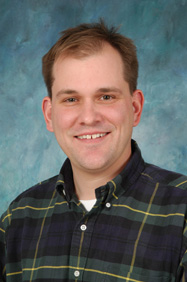 |
Paul Fey, Ph.D. |
The new research group of seven microbiologists and infectious disease researchers will study methicillin-resistant Staphylococcus aureus (MRSA) and Staphylococcus epidermidis. The group will pool their expertise and new technology to better understand and exploit their knowledge of the bacteria, in order to prevent and ultimately develop better antibiotics.
Antibiotic resistance is considered to be one of the most urgent priorities in public health. Infectious disease specialists and researchers say antibiotic resistance is responsible for increasing deaths and severity of disease, and rising health care costs. Many infectious disease experts believe the spread of staphylococcus is a public health crisis and new solutions must be found soon.
“Staph will be one of our biggest health challenges in the next five years. If the existing antibiotic drugs don’t work, we’ll be in significant trouble. We’ll have more people dying of infection,” said Dr. Hinrichs, UNMC professor of pathology and microbiology.
Antibiotic resistance is the result of microbes changing in ways that reduce or eliminate the effectiveness of drugs, chemicals, or other agents, to cure or prevent infections.
Novel concept
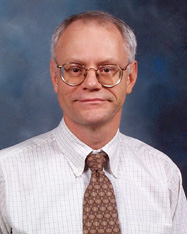 |
Steven Hinrichs, M.D. |
“We believe one of the best ways to compete with powerhouse institutions that have programs built on one individual with an international reputation is to build highly interactive programs with scientists who want to work together.”
Dr. Hinrichs noted that Drs. Dunman and Bayles, experts in staph infections, have been recruited since starting the project.
UNMC and its hospital partner, The Nebraska Medical Center, have a special interest in infectious diseases because of its cancer and organ transplantation patients, a population susceptible to a variety of infections caused by weakened immune systems. A person with one infection is at risk for complication if they acquire other infections.
Staphylococcus aureus
Staph, which is commonly present on the skin or in the nose of healthy people, is the cause of some of the most common causes of minor skin infections in the United States. Risk factors for MRSA infections include recent hospitalization or surgery, residence in a long-term-care facility or injecting-drug use. Staph infections can cause serious infections such as surgical wound infections, bloodstream infections and pneumonia. Severe infections can cause death.
Currently, about 50 to 60 percent of staph infections are resistant to multiple kinds of antibiotics, making staph much more difficult to treat. Not only are hospital-acquired MRSA infections on the rise, but so are MRSA infections in those living in the community. Physicians are baffled about how it has developed in community settings.
Over the past decade, health care surveillance officials have seen a remarkable increase in resistance among important community- and hospital-acquired pathogens, such as penicillin-resistant Streptococcus pneumoniae, vancomycin-resistant enterococci and MRSA.
According to a paper published in April in the New England Journal of Medicine, community-associated MRSA infections are now a common and serious problem. In the study, the Centers for Disease Control and Prevention (CDC) concluded the infection usually involves the skin, especially among children, and hospitalization is common.
Building research capacity
Dr. Bayles, who joined UNMC in July from the University of Idaho, will be one of the leaders of the group. His research focuses on staph’s pathogenesis — how it causes disease. He will apply his knowledge about how the bacteria lives and more importantly, how it dies. He has been studying staph since the mid-1980s.
“Staph aureus is very hard to treat and we have developed new antibiotics along the way that have allowed us to treat it,” Dr. Bayles said. “The problem is staph is acquiring resistance to a wide variety of antibiotics. Not only are more and more people dying from staph infections, the longer a person has a staph infection, the harder it is to get rid of it.”
Dr. Bayles was attracted to UNMC by the group approach to studying staph. “We’ve really amassed an eclectic collection of researchers who are all interested in staph aureus,” Dr. Bayles said. “We’re probably one of the largest groups of its kind in the world.
“I was really excited about the prospect of actually joining a team of staphylococcal researchers who are all focused on this one problem. We each have our areas of expertise that compliments each other well. I think we’ll be able to really make some very significant progress in staph research.”
Dr. Rupp, professor of infectious diseases at UNMC, said recruitment of the group shows the reputation UNMC is building in infectious diseases. His research also will focus on the clinical epidemiology of staph.
 |
Mark Rupp, M.D. |
He said history has shown that bacteria are very successful at developing mechanisms of resistance and appears it’s only a matter of time before Staphylococci become resistant to any antibiotic thrown at them.
“Within a few years of developing simple penicillins, staph made an enzyme that broke down penicillin. In the 50s, antistaphylococcal pencillins were made, but within a few years, the organism developed a resistance to them as well,” Dr. Rupp said. “Staph has developed resistance to every antibiotic developed.”
Dr. Rupp said the group is trying to understand the mechanism of resistance and how the bacteria spread in order to better exploit the organism and develop better antibiotics. In addition, he said health professionals are working hard to use antibiotics more prudently to preserve their value.
“I think this may become a public health crisis,” Dr. Rupp said. “We’ll see more and more antibiotic resistance. There needs to be incentives to study it and come up with new solutions before we reach a crisis level. Here is a group that is being proactive. I fear we may run out of antibiotics to treat this organism in the next five to 10 years, so it is vitally important to anticipate this potential calamity.”
Darwinian evolution
“They (bacteria) have a very plastic genome,” Dr. Rupp said. “The whole life cycle lasts 30 to 60 minutes. It’s not accurate in replicating its DNA like higher life forms. This is Darwinian evolution at a very, very fast pace. As has been said, when you grow up every 30 minutes, you get smart pretty fast. It takes thousands, if not millions of years, for humans to evolve and react to the environment. Bacteria, which can develop resistant traits in as short a time as a few days, are the most successful life form around. They will be here long after humans are gone.”
MRSA is one example of an evolving bacterium.
“It’s no longer a pathogen associated exclusively with the health care environment. It’s striking healthy individuals,” Dr. Rupp said. “The big fear is we’re returning to the pre-antibiotic era – a time like the 1920s when all you had to offer someone with an infection was surgical drainage and supportive care. There was little you could do. Some people are calling this the beginning of the post-antibiotic age.”
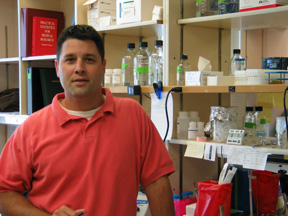 |
Paul Dunman, Ph.D. |
“Depending on what kind of antibiotic you want – to kill everything or just staph — no matter what, the bug is going to develop resistance to your antibiotic. We’re trying to improve antibiotics out there or come up with new strategy to kill the bug — new classes of antibiotics. We’re just beginning the process,” Dr. Dunman said.
“I have an idea and am working toward getting more funding on that idea,” he said.
One of Dr. Dunman’s specialties is working with DNA microarray technology. He and his research group were first to describe how to study staph using microarray technology. He has published 10 publications to date regarding the issue.
“The concept of microarray is simple. It allows you to take a snapshot of a population of cells and determine all the genes that are turned off within that population,” Dr. Dunman said.
“It sounded pretty exciting. You don’t get that opportunity very often,” said Dr. Dunman, who’s been studying staph for six years in the pharmaceutical industry. He said the industry is interested in finding new antibiotics. “The one thing I’m really excited about, is not only do we all have different research interests, they all mesh together. And we’re all actually very good friends.”
Common interest
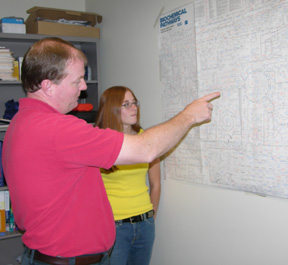 |
Greg Somerville, Ph.D., left, assistant professor, Department of Veterinary and Biomedical Sciences, University of Nebraska-Lincoln, explains the metabolic processing of glucose to a summer student, Jenny Nelson, of Morningside College. |
“The strength of the group is the integration,” he said. “We all come at this from a different perspective with common interests. Because we have a variety of perspectives, this increases the likelihood we will make progress in solving the problem. It’s a really exciting time for us in the University of Nebraska system.”
Dr. Goering, professor and interim chair of the Creighton University Medical Center Department Medical Microbiology and Immunology, is a molecular epidemiologist — one of the first in the United States — who specializes in staphylococci and MRSA. He has been studying staph for about 30 years.
As a molecular epidemiologist, he tracks the spread of the organism by the bacteria’s genetic “fingerprint.”
“It’s an interesting organism because science is a cyclical sort of thing,” Dr. Goering said. “People become aware of certain issues and everyone begins to study them. And then things have a way of sort of dropping out of sight and very frequently they come back again.
“Staph has very much been that way. It’s a human pathogen and it causes all sorts of problems that haven’t gone away. Now, with multi-drug resistance and community-acquired MRSA, it’s reared its ugly head again. It’s a bad combination.”
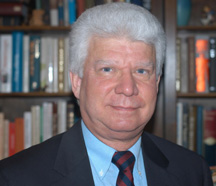 |
Richard Goering, Ph.D. |
But, he said, the battle is not lost. There are still effective drugs. He said personal hygiene and infection control in hospitals is key to breaking the cycle.
As with any infection, if it’s recognized and treated properly, it’s okay. “There has been confusion with community-acquired MRSA. It may begin with what looks like a spider bite. It’s an issue of recognizing the infection and treating it properly,” Dr. Goering said.
He said he looks forward to the group yielding new information that can combat staph.
UNMC Staphylococcus research group members speak at international conferences
Several members of the new staphylococcus research group will speak about their research during the prestigious Gordon Research Conference Aug. 21-26, at Salve Regina University, Newport, RI.
The conference will provide an international forum for the presentation and discussion of research. Of 32 invited speakers, five are members of the new research group formed at UNMC, and represent the University of Nebraska.
Paul Fey, Ph.D., will speak on “Regulation of ica gene expression in S. epidermidis,” and Paul Dunman, Ph.D., will serve as discussion leader during a session titled, “Genomics and Proteomics Under Relevant Biologic Contexts.” Ken Bayles, Ph.D., will discuss “Global transcriptional changes during S. aureus invasion of host cells.”
The presentation, “Effects of metabolism upon virulence factor production,” will be presented by Greg Somerville, Ph.D. Kelly Rice, Ph.D., instructor, pathology/microbiology, speak about her work in a talk titled, “Metabolic control of cell death in S. aureus.”
Later this fall, Mark Rupp, M.D., UNMC professor, infectious diseases, and medical director of The Nebraska Medical Center Department of Healthcare Epidemiology, will talk about staphylococcal pathogenesis at the 45th Interscience Conference on Antimicrobial Agents and Chemotherapy in New Orleans. He also will speak on new staphylococcal antimicrobials at the annual meeting of the Infectious Diseases Society of America in San Francisco.
CDC monitors MRSA infection
Currently, the CDC monitors healthcare associated MRSA infections with hospitals’ voluntarily reporting data through the National Nosocomial Infection Surveillance (NNIS) System. The system is made up of about 300 U.S. hospitals, including The Nebraska Medical Center.
Invasive and community-associated MRSA infections are monitored using the Active Bacterial Core Surveillance (ABC’s) System, a laboratory- and population-based surveillance system for invasive bacterial pathogens of public health importance. Ten sites across the United States currently participate in the ABC’s, representing a population of more than 38 million persons.
“Significant changes have occurred in Staphylococcus that make research in this area important, said Denise Cardo, M.D., director, CDC Division of Healthcare Quality Promotion. “The problem of drug resistant staph in healthcare settings continues to grow. An emergence of drug resistant staph outside the healthcare setting is affecting young healthy individuals. Additional research into the nature of staph bacteria can help us improve treatment and prevention strategies when addressing these old and new challenges that the staphylococcus bacteria present.”